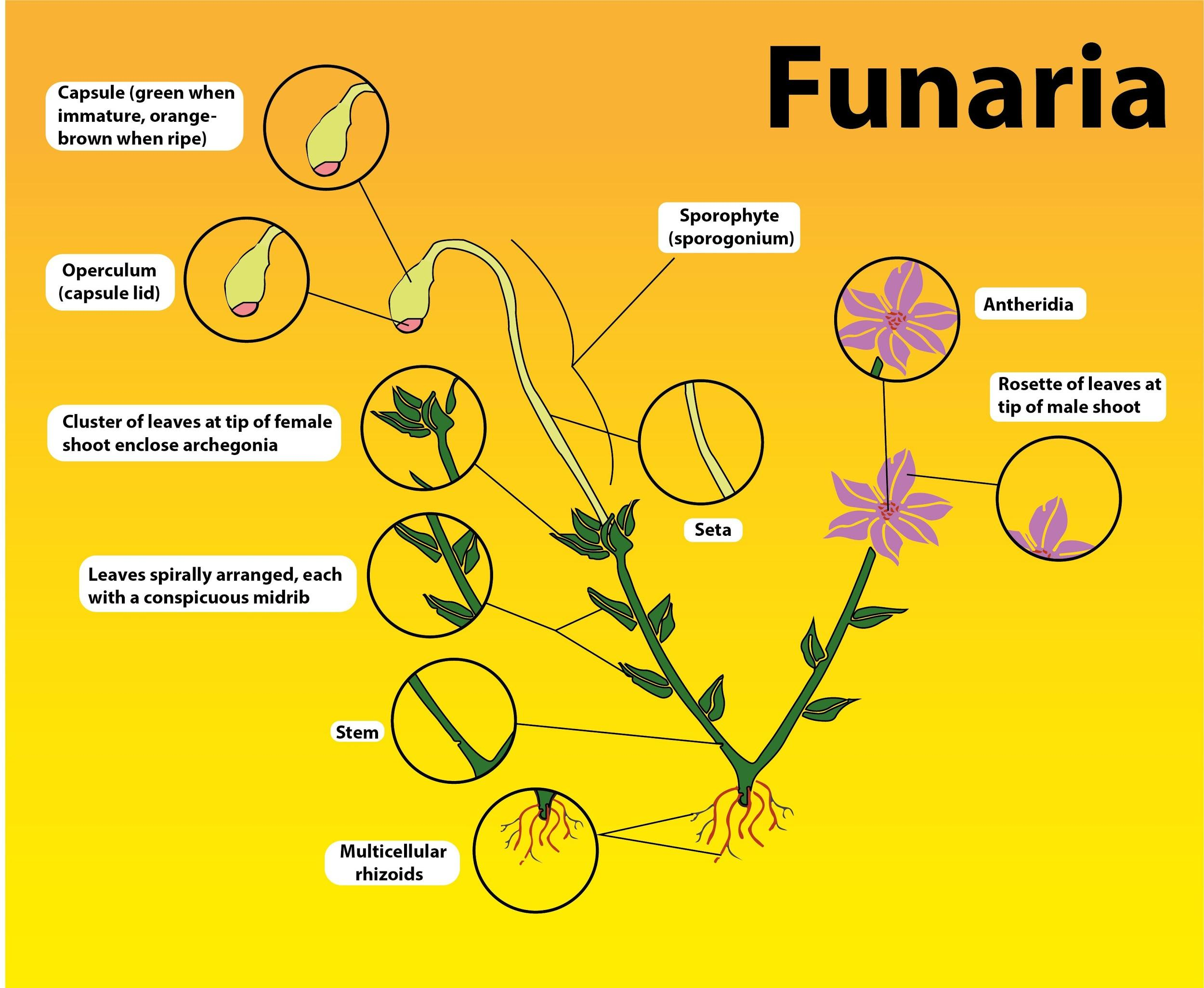Answer
396.9k+ views
Hint: Funaria sporophyte has an embedded foot, an elongated curved seta, and a pyriform terminal capsule. The sporophyte of funaria begins its development within the female reproductive organ. It acts as a fertilization site as well.
Complete step by step answer:
Funaria's sporophyte starts to evolve within the Archegonium. A mature archegonium has the form of a flask, borne on a short stalk. It has a basal swollen venter portion and an elongated neck. A two-layered jacket covers the venter, while the jacket around the neck is lined singly.
The antherozoids pass the vicinity of the archegonial neck during heavy rains and swim down to the center. Any antherozoid fuses to form a zygote (2n) with an embryo. The egg will remain in the archegonium even after fertilization until it develops into a sporophyte. The spore-forming form of the plant is a sporophyte. The zygote soon secretes a wall of cells and becomes the oospore. The oospore separates and redivides into embryos. The embryo then becomes a sporophyte or sporogonium. Once the sporophyte is fully developed, it is released from the archegonium.

Funaria is usually referred to as 'cord moss.' It is distributed worldwide. The Common Species is Funaria hygrometrica. It grows on rocks, trunks of trees, damp walls, and wet soils in dense tufts. They assist in the soil-forming process. That process is called Pedogenesis.
So, the correct answer is, ‘Archegonium’.
Note: In Funaria the sexual reproduction is oogamous. The male reproductive system is known as antheridium and the archegonium is the female reproductive system. Funaria is monoecious (male and female sex organs are present on the same thallus) and autoicous (the development of antheridia and archegonia on different branches of the same thallus). In terminal clusters, the sex organs are borne on leafy gametophores.
Complete step by step answer:
Funaria's sporophyte starts to evolve within the Archegonium. A mature archegonium has the form of a flask, borne on a short stalk. It has a basal swollen venter portion and an elongated neck. A two-layered jacket covers the venter, while the jacket around the neck is lined singly.
The antherozoids pass the vicinity of the archegonial neck during heavy rains and swim down to the center. Any antherozoid fuses to form a zygote (2n) with an embryo. The egg will remain in the archegonium even after fertilization until it develops into a sporophyte. The spore-forming form of the plant is a sporophyte. The zygote soon secretes a wall of cells and becomes the oospore. The oospore separates and redivides into embryos. The embryo then becomes a sporophyte or sporogonium. Once the sporophyte is fully developed, it is released from the archegonium.

Funaria is usually referred to as 'cord moss.' It is distributed worldwide. The Common Species is Funaria hygrometrica. It grows on rocks, trunks of trees, damp walls, and wet soils in dense tufts. They assist in the soil-forming process. That process is called Pedogenesis.
So, the correct answer is, ‘Archegonium’.
Note: In Funaria the sexual reproduction is oogamous. The male reproductive system is known as antheridium and the archegonium is the female reproductive system. Funaria is monoecious (male and female sex organs are present on the same thallus) and autoicous (the development of antheridia and archegonia on different branches of the same thallus). In terminal clusters, the sex organs are borne on leafy gametophores.
Recently Updated Pages
Basicity of sulphurous acid and sulphuric acid are

What is the stopping potential when the metal with class 12 physics JEE_Main

The momentum of a photon is 2 times 10 16gm cmsec Its class 12 physics JEE_Main

Using the following information to help you answer class 12 chemistry CBSE

Which of the following would not be a valid reason class 11 biology CBSE

Why should electric field lines never cross each other class 12 physics CBSE

Trending doubts
Difference Between Plant Cell and Animal Cell

Difference between Prokaryotic cell and Eukaryotic class 11 biology CBSE

Fill the blanks with the suitable prepositions 1 The class 9 english CBSE

Fill the blanks with proper collective nouns 1 A of class 10 english CBSE

Change the following sentences into negative and interrogative class 10 english CBSE

Give 10 examples for herbs , shrubs , climbers , creepers

What organs are located on the left side of your body class 11 biology CBSE

What is BLO What is the full form of BLO class 8 social science CBSE

How do you solve x2 11x + 28 0 using the quadratic class 10 maths CBSE



